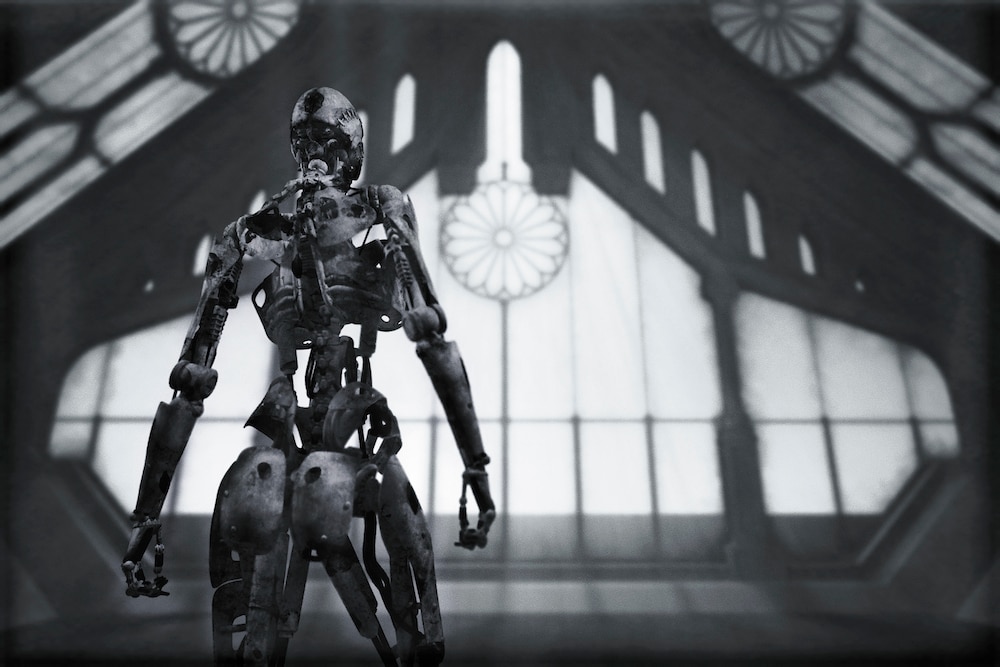Create a free profile to get unlimited access to exclusive videos, sweepstakes, and more!
Robot skeletons can now grow themselves like human bones
And you thought sci-fi robots were tough.

Robocop only wishes he had a skeleton that could grow back if he ever broke a metal bone.
If a cop with a robotic skeleton and the voice of Peter Weller isn’t totally indestructible, our bones have no chance. At least they had no chance in the ‘80s. Now, researchers inspired by the growth of human bone have developed a combination of materials that can grow and morph into different shapes before hardening — and it hardens through a bone development process that uses the same materials we have in our skeletons.
Bone actually starts out flexible. It would be nearly impossible for babies to be born if their skulls were completely hard from the beginning, which explains those soft spots called fontanelles. That tissue grows harder after birth. This is how researcher Edwin Jager got the idea to create a material that can flex in the beginning, and then gradually sets and hardens just like actual bones. Jager coauthored a study recently published in Advanced Materials.
“We chose alginate for our material because it is a soft gel needed for good actuator performance, and because it can be easily processed with cell membrane nanofragments (immobilization) and synthesis of the electroactive polymer,” he told SYFY WIRE.
Alginate is naturally found in brown algae cells, and when water is added, it turns thick and gummy. It is already used for medical applications involving molds (like as those used for dental impressions). This is ideal for an actuator since actuators allow things to move. Jager and his team took it to the next level by creating something that could be used to help with recovery from bone fractures. It could either be surgically incorporated into the bone or used in microbes that are injected into the body, where they would fill in the gaps and then begin to harden.
Something needs to give this sci-fi material an assist in order for it to be able to fill in just the right amount of missing bone volume and be able to bend and reshape itself before turning into something as hard as bone. Jager and his team experimented with a microbot made out of alginate, since the treatments of the future are going there. They attached an electroactive polymer (EAP) to one side of the gel. These kinds of polymers are able to warp themselves over and over, and are also lightweight and won’t fracture. Broken bones don’t need more fractures.
“This electroacitve polymer we used, polypyrrole, can be electrochemically oxidized and reduced by applying a low potential which causes sodium ions to enter (or leave) the polypyrrole layer, making it swell (or shrink),” Jager said. “When attached to the gel layer, forming a bilayer actuator, this reversible volume change results in a bending movement.”
The artificial bone also needs to be able to harden once it takes shape, so the researchers added biomolecules on the other side, which would eventually immobilize it. They were able to see it in action by immersing it in a cell culture medium made of calcium and phosphor. This liquid was full of calcium ions, which created conditions as similar to the inside of the human body as possible. The cell membrane nanofragments in the gel started forming calcium phosphate minerals much like human bone does as it hardens. It is capable of doing even more than that.
When the researchers made certain patterns in the gel, they found that the patterns would drive it to take different shapes when voltage was applied. What patterns should be used depends how a bone is broken. Those patterns act to predetermine movements by making sure that the artificial bone will bend to the shape of the break as precisely as it can. It was able to wrap itself around a chicken bone and grow together with it, which has huge implications for use in humans. Jager is optimistic about the robo-skeleton material working with human bone.
“We are looking in the biocompatibility of our devices and materials with living cells,” he said. “The individual components show good cell viability. We now need to prove this for the combined materials, along with specific cells involved in the applications we have in mind.”


























